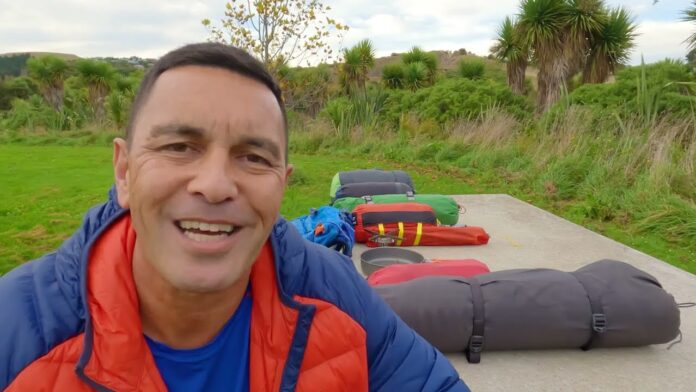If you’re someone who loves spending time in the great outdoors, then backpacking is a perfect activity for you. It allows you to explore nature, disconnect from the hustle and bustle of daily life, and challenge yourself physically and mentally. However, before you head out on your next backpacking trip, it’s important to make sure you have all the necessary gear. In this blog post, we’ll take an in-depth look at the essential items you should have in your backpack when embarking on a backpacking adventure.
Backpack
The first item on our list is perhaps the most important one – the backpack itself. This will be your trusty companion throughout your trip, carrying all your gear and supplies, so it’s crucial to choose the right one. When it comes to backpacks, there are several factors you need to consider, including size, weight, comfort, and durability.
Size
The size of your backpack will depend on the duration of your trip and how much gear you need to carry. For a single day hike, a small backpack (less than 20 liters) might suffice. However, for longer trips, you’ll need a larger backpack (around 50 liters or more) that can hold all your gear comfortably. Keep in mind that packing too lightly can leave you without essential items, while overpacking can result in a heavy and uncomfortable backpack.
To determine the right size for your backpack, make a list of all the items you plan to bring and estimate their total volume. Remember to account for any bulky items such as a tent or sleeping bag. This will give you a good idea of what size backpack you’ll need.
Weight
When it comes to backpacking, carrying a heavy load can quickly become a burden. That’s why it’s crucial to consider the weight of your backpack before making a purchase. Look for backpacks made from lightweight materials such as nylon or polyester and avoid those with unnecessary features that add extra weight.
In addition to the weight of the backpack itself, you also need to consider the weight distribution. A well-designed backpack should evenly distribute the weight across your hips and shoulders, making it more comfortable to carry. Look for backpacks with padded shoulder straps and a padded hip belt for added comfort.
Comfort
Since you’ll be carrying your backpack for long periods, it’s vital to choose one that fits comfortably on your body. This is where trying on different backpacks in-store can come in handy. Make sure to adjust the shoulder straps and hip belt to see how they feel when the backpack is fully loaded. The goal is to find a backpack that distributes the weight evenly and doesn’t cause any discomfort or pain.
Another factor to consider is the ventilation system. A backpack with good ventilation will keep your back cool and dry, preventing sweat buildup and potential chafing. Look for backpacks with mesh panels on the back or those with a suspended mesh back panel.
Durability
Lastly, you want a backpack that can withstand all the wear and tear of backpacking trips. Look for backpacks made from high-quality materials and with reinforced stitching. Pay attention to the zippers and make sure they are durable and won’t break easily. Investing in a quality backpack will save you money in the long run, as you won’t have to constantly replace it after each trip.
Tent

One of the joys of backpacking is spending the night under the stars. However, a good tent is essential for providing shelter and protection from the elements. When choosing a tent for backpacking, there are several factors to consider.
Weight
Similar to backpacks, the weight of your tent is crucial when backpacking. You’ll want to choose a lightweight tent that won’t add too much extra weight to your backpack. Look for tents made from lightweight materials like nylon or silnylon, and opt for a two-person tent instead of a four-person one to save on weight.
Size
The size of your tent will depend on how many people will be using it. A two-person tent is usually the ideal size for backpacking, but if you’re going solo, a one-person tent might be more suitable. Keep in mind that a larger tent will also take up more space in your backpack.
Weather resistance
When you’re out in nature, you have no control over the weather. That’s why it’s crucial to choose a tent that can withstand different weather conditions. Look for tents with waterproof floors and rainflys to keep you dry during rainy days. You’ll also want a tent with good ventilation to prevent condensation buildup inside.
Ease of setup
When it comes to setting up your tent, you want it to be as quick and effortless as possible. After a long day of hiking, the last thing you want is to spend an hour struggling with tent poles and stakes. Look for tents with simple designs and easy-to-follow instructions, or even better, practice setting it up before your trip.
Sleeping Bag

A good night’s sleep is crucial when backpacking, and a quality sleeping bag can make all the difference. Here are some things to consider when choosing a sleeping bag for your backpacking trip.
Temperature rating
Sleeping bags come with temperature ratings that indicate the lowest temperature at which a person can sleep comfortably. Make sure to choose a sleeping bag with a temperature rating suitable for the climate you’ll be camping in. It’s always better to have a warmer sleeping bag than needed than a cooler one.
Weight
Similar to other gear, the weight of your sleeping bag is essential when backpacking. Look for lightweight sleeping bags made from down or synthetic materials. Down sleeping bags tend to be lighter, but they come at a higher cost.
Size
Sleeping bags come in different sizes, and it’s important to choose one that fits your body comfortably. Consider your height and weight and make sure the sleeping bag allows for enough room to move around but not too much space that it creates cold air pockets. You can also opt for a mummy-style sleeping bag that is more fitted and lightweight.
Insulation
The type of insulation in your sleeping bag will affect its weight, compressibility, and warmth. Down insulation is lighter and more compressible but can be expensive. Synthetic insulation is more affordable but tends to be heavier and less compressible. Consider your budget and the expected temperature when choosing between the two.
Cooking Gear
Part of the backpacking experience is cooking your meals outdoors. To do so, you’ll need some essential cooking gear. Here are some items to consider bringing with you on your next trip.
Lightweight stove
A lightweight stove is a must-have for backpacking trips. Look for stoves made specifically for backpacking, as they tend to be smaller and more compact than traditional camping stoves. You can choose between canister stoves, which use canisters of compressed fuel, or liquid fuel stoves, which use white gas or kerosene.
Cookware
You’ll need something to cook your meals in, and a good option for backpacking is a lightweight pot or pan made from titanium or aluminum. These materials are durable, lightweight, and conduct heat well. You can also opt for a set that includes multiple pots and pans, allowing you to prepare more complex meals.
Utensils
Don’t forget to pack utensils for eating and cooking. Lightweight options include sporks (a combination of a spoon and fork) and collapsible utensils that take up minimal space in your backpack. Make sure to bring enough for everyone in your group.
Water filter
Water is essential for staying hydrated on your backpacking trip, and you can’t always rely on finding clean water sources. That’s why it’s important to bring a water filter with you. Look for compact and lightweight options that allow you to filter water from different sources.
Water bottle
Staying hydrated is crucial when backpacking, and bringing a reliable water bottle is essential. Here are some things to consider when choosing a water bottle for your trip.
Material
Water bottles come in different materials, such as plastic, stainless steel, or glass. When backpacking, it’s best to opt for a plastic or stainless steel water bottle, as they are lightweight and durable. Glass water bottles are heavier and more prone to breaking, making them less suitable for backpacking trips.
Size
The size of your water bottle will depend on your water needs and the availability of water sources along your route. Plan on carrying at least 2 liters of water per day. If you’ll have access to water sources, opt for a smaller bottle and refill as needed.
Easy to clean
You’ll want to make sure your water bottle is easy to clean while on your trip. Look for bottles with wide mouths, making it easier to reach inside and scrub. You can also opt for a collapsible water bottle that takes up less space in your backpack when empty.
First aid kit
Accidents can happen anywhere, even when you’re out in nature. That’s why it’s imperative to pack a first aid kit with you on your backpacking trip. Here are some items to include in your kit.
Basic first aid supplies
Your first aid kit should include the essentials such as band-aids, gauze, medical tape, antiseptic wipes, and pain relievers. These items can come in handy for treating minor cuts and scrapes, blisters, and headaches.
Prescription medication
If you have any prescription medication, make sure to bring enough for the duration of your trip. It’s also a good idea to include some over-the-counter medications such as antihistamines and anti-inflammatory pills.
Emergency supplies
In case of a more severe emergency, it’s crucial to have some basic supplies on hand. These include a whistle, a small knife, a compass, and a thermal blanket. You can also include a small booklet with basic first aid instructions, just in case.
Navigation tools
When you’re out in nature, it’s important to have the necessary tools to navigate your way through the terrain. Here are some essential navigation tools to bring on your backpacking trip.
Map and compass
A map and compass are essential tools for navigating when you’re off the beaten path. Make sure to get a detailed map of the area you’ll be backpacking in and familiarize yourself with how to use a compass beforehand.
GPS device
A GPS device can be a useful addition to your navigation tools, especially if you’re not familiar with reading maps and using a compass. There are many handheld GPS devices specifically designed for outdoor activities that come with detailed maps and other features like tracking and route planning.
Watch
Having a watch with you on your backpacking trip is essential for keeping track of time and staying on schedule. Look for watches with GPS and altimeter functions, as they can come in handy for navigation and tracking your progress.
Clothing
When it comes to packing clothes for a backpacking trip, it’s all about finding the perfect balance between comfort and weight. Here are some things to consider when choosing your clothing items.
Layering
Layering is crucial when it comes to backpacking, as it allows you to adjust your clothing to different weather conditions. Start with a base layer made from moisture-wicking material, then add a mid-layer such as a fleece jacket, and finally a waterproof and windproof outer layer.
Material
When choosing your clothing items, opt for materials that are lightweight, quick-drying, and breathable. Avoid cotton, as it takes a long time to dry and can leave you feeling cold and uncomfortable if it gets wet.
Footwear
Your feet are your most important asset when backpacking, so choosing the right footwear is crucial. Look for hiking boots or trail shoes that provide good ankle support and have a sturdy sole. Make sure to break them in before your trip to prevent blisters.
Accessories
Don’t forget to pack accessories such as a hat, sunglasses, and gloves for protection against the sun, wind, and cold. You can also bring a buff or bandana that can serve multiple purposes, from keeping sweat out of your eyes to serving as a makeshift washcloth.
Food
Food is fuel, and you’ll need plenty of it to keep your energy levels up during your backpacking trip. When planning your meals, consider the following factors.
Calorie density
When backpacking, you want to choose foods that are high in calories but don’t take up too much space in your backpack. Look for dehydrated meals, energy bars, and nuts and seeds, which provide a lot of calories in a small package.
Variety
While you may not have access to a kitchen while backpacking, that doesn’t mean your meals have to be boring. Plan for different flavors and textures by bringing a variety of foods, including dried fruits, jerky, and spices.
Cooking equipment
When packing food, make sure to consider the cooking equipment you’ll need. Bring a lightweight pot or pan and a stove that can accommodate it. Remember to also bring utensils, bowls, and cups for eating.
Personal items
Lastly, don’t forget to pack personal items that will make your backpacking trip more enjoyable. Here are some suggestions.
Sunscreen and insect repellent
Protect your skin from the sun and pesky bugs by packing sunscreen and insect repellent. Look for travel-sized options to save space in your backpack.
Toiletries
You’ll still need to take care of personal hygiene while backpacking, so make sure to pack toiletries such as a toothbrush, toothpaste, and biodegradable soap.
Phone and charger
While you may want to disconnect from technology during your trip, it’s always a good idea to have a phone with you in case of emergencies. Bring a portable charger to keep your phone charged throughout your trip.
Headlamp
A headlamp is a handy item to have if you plan on hiking or setting up camp after dark. It leaves your hands free and allows you to see in the dark.
Conclusion
Embarking on a backpacking trip can be an exhilarating and rewarding experience. However, it’s important to have all the necessary gear to make your trip safe and comfortable. Make sure to choose a backpack that fits comfortably and can hold all your gear, a tent that provides shelter and protection, and a sleeping bag that will keep you warm at night. Consider adding cooking gear, water bottles, first aid kits, navigation tools, and appropriate clothing and food items to your backpack. Lastly, don’t forget to pack personal items that will make your trip more enjoyable. With these essential items in your backpack, you’ll be ready for your next backpacking adventure!









